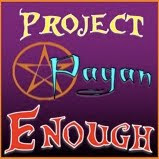The apartment which Beloved Wife and I are renting in Seattle doesn't have a central heating system. It comes with electric oil-filled radiators and a woodstove, and our landlady pays utilities, including wood for the woodstove. (I think that bit is very smart on her part, because then she has some say in the management of the woodpile. We once lived in a house with two fireplaces, where the prior tenants hadn't taken very good care of the woodpile... and it was a damp, icky, disintegrating mess.)
I used the woodstove at Samhain for burning mementos to my ancestors and my dead, but wasn't sure we'd ever really use it for heat. I don't have any woodstove experience, in spite of the fact that my parents and my aunt and uncle heat with woodstoves. And although I know how to build campfires and fireplaces fires, I don't know much about building fires in stoves, and I can tell it's a very different sort of thing. (There's no grating; this stove is too tiny to put pieces crosswise... er?) I had this uneasy feeling, too -- while I liked the idea of not using fossil fuel or electricity, and not paying a big utility company to heat my house, I wasn't so sure about the environmental impact of burning wood. Plus, I have asthma -- do I want to heat my house this way?
Then the temps dropped to the 20s F, and there was just no way to get our apartment above 60F with the electric heaters. And there was the threat of electricity outages due to wind and ice. I didn't want to be learning how to use the stove when I couldn't see and it was 50F in our flat.
It was definitely time to fire up the woodstove.
And while I didn't find myself terribly proficient at managing it yet, I did find myself really appreciating, even enjoying, having a fire in the woodstove. There's a subjective difference between heat from a woodstove and heat from radiators, forced-air systems, and the like. I can't quite explain what it is, but it felt different, and I liked it.
I've also found myself appreciating the beauty of wood -- all the different shades of cedar, the sheen of maple -- in a way that's somewhat different from when woodworking or whittling. And I understand in a first-hand way now how Doug fir is fire-resistant, and how seasoned cedar kindling really is different from freshly-split cedar kindling from a seasoned log. There's something I really like about becoming familiar with, and appreciating, wood in this way. It feels akin to honoring the sacrifice of an animal I eat, the sacrifice of the Horned God, or to honoring the death of the plants I eat, the sacrifice of Lugh or the Grain God.
When the temperatures warmed back up, so that we could go back to keeping the house reasonably warm using the electric heaters alone... I felt a little lost without a fire to tend. One website I was reading recently summed it up nicely: heating with a wood-burning stove is a little like having a pet. Its presence is always there; it requires a certain amount of attention; it's warm; it can feel kind of affectionate.
I decided to do some research on how to build a good fire in a woodstove. My perfectionist self was feeling like there must be a better way to get a fire going than my so-so efforts thus far.
I discovered a handful of interesting things out there on the web; as with so much on the internet, some were useful, some less so.
There are a couple of methods to building a new fire in a woodstove that I'm going to try; there's a rather different way of starting new logs from existing coals that I'm also going to try. (Physics!) Crumpled newspaper, which is how I learned to do start fire growing up (gosh, doesn't that sound like I was a juvenile delinquent), does irritating things in a woodstove, and that's been driving me batty; so I'm learning to make "Nantucket Knots" (which somehow remind me of Brigid's Crosses). Physics again!
I'm enjoying the geekdom.
I also know a little about the guy our landlady buys our wood from. I feel good about how buying wood from him helps him support himself.
I like how, if you know where your wood comes from and you buy it locally, you can help support your local economy, can help support sustainable wood harvesting, can help conserve fossil fuel by not hauling your wood long distances. I like participating in the carbon cycle this way. I like getting a little off the grid. I like how a good woodlot is a renewable resource. I like how, if you use your woodstove well, you can produce less pollution than if you heat your home by most forms of commercial heating.
So I am a cautious convert to this wood-heat thing.
Which is not at all what I expected.
Friday, 9 January 2009
Subscribe to:
Post Comments (Atom)









No comments:
Post a Comment